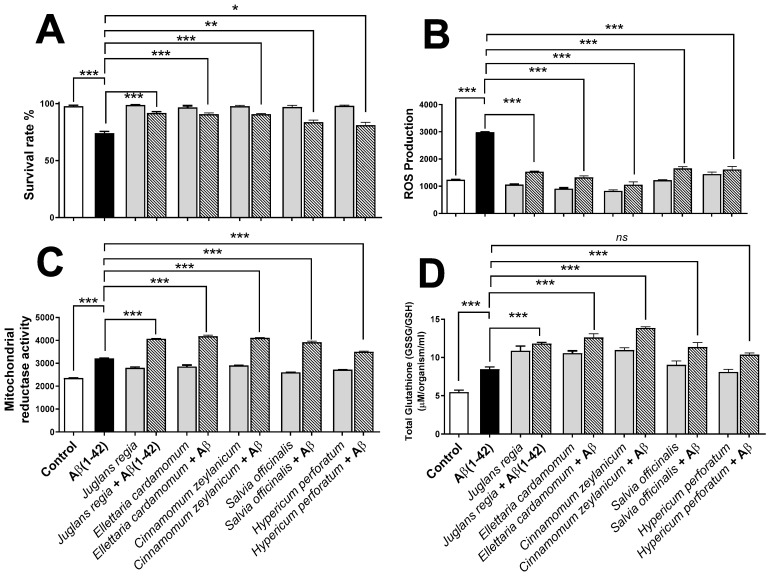Figure 5.
Evaluating the ability of plant extracts to ameliorate the effects of amyloid beta Aβ (1-42) in Globodera pallida. (A) Percentage survival of G. pallida was determined by visual counting of living/dead organisms following exposure to Aβ (1-42) alone, plant extracts, or plant extracts in combination with Aβ (1-42). (B) ROS production was monitored using the DCFH-DA assay, and the fluorescence (Ex: 495 nm/Em: 529 nm) was measured every 30 min for 24 h; the results are reported as areas under the curve (AUC). (C) For mitochondrial reductase activity, G. pallida were incubated with Alamar Blue, and the fluorescence (Ex: 530 nm/Em: 590 nm) was measured every 30 min for 24 h. The results are reported as AUC. (D) Total glutathione is the ratio of oxidized glutathione (GSSG) to reduced glutathione (GSH), which is a measure of cellular oxidative stress. It was determined by employing OxiSelect™ Total Glutathione assay in the presence of nicotinamide adenine dinucleotide phosphate (NADPH) at 405 nm. The total glutathione content in unknown samples is determined by comparison with the predetermined glutathione standard curve. In each type of experiment, the nematodes were exposed to Aβ (1-42) alone (100 µM), plant extracts (n = 5; 100 µg/mL), or plant extracts (n = 5; 100 µg/mL) in combination with 100 µM Aβ (1-42). Control represents untreated cells (vehicle control); heat-killed G. pallida (not shown) were also performed as controls. Approximately 50 G. pallida J2 organisms per replicate were used in survival assays, ~100 organisms were used in mitochondrial reductase and ROS assays, and glutathione studies involved ~1000 organisms per replicate. Data are mean ± SEM (n = 3), * p < 0.05, ** p < 0.01, *** p < 0.001 (significance), and ns (not significant) for the statistical comparisons indicated (one-way analysis of variance).

